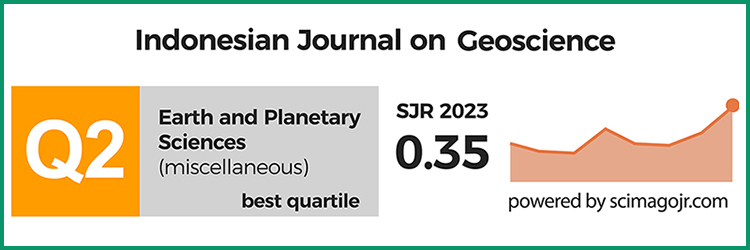Ignimbrite Analyses of Batur Caldera, Bali, based on 14C Dating
DOI:
https://doi.org/10.17014/ijog.4.3.189-202Keywords:
14C dating, ignimbrite, pumice clast, pyroclastic airfall deposit, dacite, phreatomagmaticAbstract
https://dx.doi.org/10.17014/ijog.vol4no3.20094
The Batur Caldera, in the northeastern part of Bali Island, is an elliptical collapse structure 13.8 by 10 km in size and another circular composite collapse structure with a diameter of 7.5 km in its centre. Two stages of the collapse were interrupted by silicic andesite lavas and domes. The first collapse was initiated by the eruption of about 84 km3 of the dacitic "Ubud Ignimbrite", about 29,300 years B.P., which caused a steep-walled depression about 1 km deep. The second ignimbrite was erupted from a large crater about the present lake, and it produced about 19 km3 of a similar voluminous dacitic ignimbrite, called the "Gunungkawi Ignimbrite" about 20,150 years B.P. This second eruption trig- gered a second collapse, which created the central circular caldera, and formed a basin structure. Both the Ubud and Gunungkawi Ignimbrites consist of a similar dacitic composition, white to red (the most abundant nearly 90 %) and dark grey to black dacitic pumice clasts. The large clasts, up to 20 cm in diameter, are in the non-welded ignimbrite, particularly in the upper part of the Gunungkawi Ignimbrite. The intracaldera ignimbrite, called the "Batur Ignimbrite" about 5 km3 in volume is a densely welded ignimbrite and generally shows typical welded features. The ignimbrite comprises at least five different flow units, separated by thin (15 - 40 cm) welded pumiceous airfall deposits, with flattened pumice clasts. Another large eruption occurred about 5,500 years B.P., producing around 0.09 km3 andesitic ignimbrite. This was initiated by phreatomagmatic eruptions, indicated by thick phreatomagmatic and surge deposits, underlying the ignimbrite. The caldera and its vicinity are partly filled, and variably mantled by later eruptive products of dacitic and andesitic phreatomagmatic and airfall deposits.
References
Bailey, R.A., Dalrymple, G.B., and Lanphere, M.A., 1976. Volcanism, structure, and geochronology of Long Valley Caldera, Mono County, California. Journal of Geophysical Research, 81, 725 pp.
Bemmelen, R.W.Van, 1949. The geology of Indonesia. Vol I A. Government Printing Office, The Hague, p.505-506. Bemmelen, R.W.Van, 1961. Volcanology and geology of Ignimbrites in Indonesia, North Italy and U.S.A., 46 pp.
Carr, W.J., 1964. Structure of part of the Timber Mountain dome and caldera, Nye County, Nevada. U.S. Geological Survey Professional Paper 501-B B 16-B 19.
Christiansen, R.L., Lipman, P.W., Carr, W.J., Byers, F.M.Jr., Orkild, P.P., and Sargent, K.A., 1977. Timber Mountain - Oasis Valley Caldera Complex of Southern Nevada. Geological Society of America Bulletin, 88, p.943-959.
Curray, J.R., Shor, G.G., Raitt, R.W., and Henry, M., 1977. Seismic refraction and reflection studies of crustal structure of the eastern Sunda and western Banda arcs. Journal of Geophysical Research, 82, p.2479-2489.
Fisher, R.V., 1966. Rocks composed of volcanic fragments and their classification. Earth Science Review, 1, p.287-298.
Hamilton, W., 1978. Tectonic map of Indonesia. U.S. Geological Survey.
Hamilton, W., 1979. Tectonics of the Indonesian region. U.S. Geological Survey Professional Paper, 1078 pp.
Hattherton, T. and Dickinson, W.R., 1969. The relationship between andesitic volcanism and seismicity in Indonesia, the Lesser Antilles, and other island arcs. Journal of Geophysical Research, 74, p.5301-5310.
Hutchison, C.S., 1976. Indonesian active volcanic arcs: K, Sr, and Rb variation with depth to the Benioff zone. Geology, 4, p.407-408.
Hutchison, C.S., 1981. Review of the Indonesian volcanic arc. In: Barber, A. J. and Wiryosujono, S (Eds.), The Geology and Tectonics of Eastern Indonesia. Geological Research and Development Centre Special Publication, 2, p.65-80.
Kadar, D., 1972. Upper Miocene planktonic foraminifera from Bali. Jaarboek Geologische Bundensant, Sonderb, 19, p.8-70.
Kadar, D., 1977. Upper Pliocene planktonic foraminiferal zonation of Ambengan drill hole, southern part of Bali island. Geological Research Development Centre (Indonesia) Special Publication, 1, p.137-158.
Katili, J.A., 1973. Geochronology of West Indonesia and its implication on plate tectonics. Tectonophysics, 19, p.195-212.
Kemmerling, G.L.L., 1917. De vulkanen goenoeng Batur en goenoeng Agoeng op Bali. Jaarboek van het Mijnwezen, Nederlandsch-Oost Indie, p.0-74.
Kusumadinata, K., 1964. The eruption of the Batur volcano in Bali in 1963. Volcanological Survey of Indonesia, unpublished.
Kusumadinata, K., 1979. Catalogue of references on Indonesian volcanoes with eruptions in historical time. Volcanological Survey of Indonesia Special Publication (in Indonesian with English abstract), 820 pp.
Lipman, P.W., 1975. Evolution of the Platoro caldera complex and related volcanic rocks, southern San Juan Mountains, Colorado. U.S. Geological Survey Professional Paper, 852, p.128.
Marinelli, G. and Tazieff, H., 1968. L'Ignimbrite et la caldera de Batur (Bali, Indonesie). Bulletin Volcanologique, 32, p.89-120.
McBirney, A.R., 1980. Mixing and unmixing of magmas. Journal of Volcanology and Geothermal Research, 7, p.357-371.
Neumann van Padang, M., 1951. Catalogue of the active volcanoes of the world. Part I. International Volcanological Association.
Purbo-Hadiwidjojo, M., 1972. The geologic map of Bali, Indonesia, scale 1:250.000. Geological Survey of Indonesia.
Samud, 1968. Laporan pendahuluan penyebaran lava G. Batur (Bali) 1968. Volcanological Survey of Indonesia, unpublished.
Sclater, J.G. and Fisher, R.L., 1974. Evolution of the east Central Indian Ocean, with emphasis on the tectonic setting of the Ninetyeast Ridge. Geological Society of America Bulletin, 85, p.683-702.
Self, S. and Rampino, M.R., 1982. Historic eruptions of Tambora (1815), Krakatau (1883) and Agung (1963), their stratospheric aerosols and climatic impact. Quaternary Research, 18, p.127-143.
Smith, R.L., 1979. Ash flow magmatism. In: Chapin and Elston (eds.), Ash-flow tuffs, Geological Society of America Special Paper, 180, p.5-27.
Smith, R.L. and Bailey, R.A., 1968. Resurgent cauldrons. Geological Society of America Memoir, 116, p.613-662.
Sparks, R.S.J., Wilson, L., and Hulme, G., 1978. Theoretical modelling of the generation, movement and emplacement of pyroclastic flow by column collapse. Journal of Geophysical Research, 83, p.1727-1739.
Stehn, C.E., 1928. De Batoer op Bali en zijn eruptie in 1926. Vulkanologisch en Seismologisch Mededeelingen, 9, p. 1-67.
Wheller, G.E. and Varne, R., 1986. Genesis of dacitic magmatis mat Batur volcano, Bali, Indonesia: Implications for the origin of stratovolcano calderas. Journal of Volcanology and Geothermal Research, 28, p. 363-378.
Whitford, D.J., 1975. Strontium isotopic studies of the volcanic rocks of the Sunda arc, Indonesia, and their petrogenetic implications. Geochemica et Cosmochimica Acta, 39, p.1287-1302.
Williams, H., 1941. Calderas and their origin. California University, Department of Geology Science Bulletin, 25, p.239-346.
Wilson, C.J.N. and Walker, G.P.L., 1982. Ignimbrite depositional facies: the anatomy of a pyroclastic flow. Geological Society of London Journal, 139, p.581-592.
Wright, J.V., Smith, A.L. and Self, S., 1980, A working terminology of pyroclastic deposits. Journal of Volcanology and Geothermal Research, 8, p. 315-336.
Yokoyama, I., 1981. A Geophysical interpretation of the 1883 Krakatau eruption. Journal of Volcanology and Geothermal Research, 9, p.359-378.
Yokoyama, I., 1982. Author's reply to the comments by S. Self and M.R. Rampino. Journal of Volcanology and Geothermal Research, 13, p.384-386.
Yokoyama, I. and Siswowidjojo, S., 1970. A gravity survey on and around Batur Caldera, Bali. Bulletin of the Earthquake Research Institute, 48, p.317-329.



















